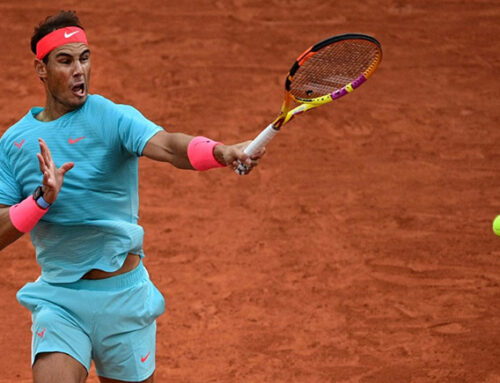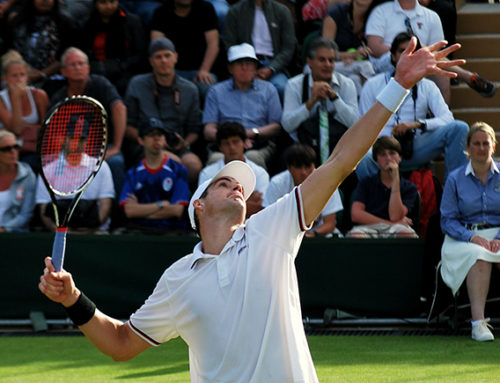How To Choose A New Racquet
Choosing a new racket can be a difficult and puzzling decision for most players. In truth it is a question I see asked over and over again on internet message boards: what new racket should I buy? This is usually followed by a brief description of the player’s level and style then the deluge of responses come from well meaning people parroting old wive’s tales they heard somewhere else. In reality the process of choosing a new racket should be truly quite simple, and today’s Tactical Tennis article will be focused purely on that: how should you choose a new racket?
Don’t Believe The Hype
Following the dialogue online, it stands out that tennis racket manufacturers have managed to control the public dialogue when it comes to racket selection. Discussions talk about the size of the sweet spot, the ‘power’ of the racket, the ‘feel’ and ‘control’ and other marketing terms that are either not really applicable or poorly understood. The first step in choosing a new racket wisely is this: don’t believe the hype. There hasn’t been a genuine breakthrough in racket technology since the Prince Graphite was introduced 1980. Yes, 1980. There hasn’t been a substantial breakthrough in racket technology in the last 33 years. For tennis racket manufacturers, there is a drive to convince people to buy rackets more frequently than they actually need them. A well built racket will last for years, so the racket companies fall over one another to create buzz about the latest and greatest technology. However the truth of it is that the rackets from the different companies are essentially interchangeable, and differ largely only in the shape of their grips and the paint jobs. Why?
It’s Physics, Dummy
The hitting of a tennis ball is, at its core, momentum transfer. We are taking a heavy object, striking a less heavy object with it and putting some of the momentum and kinetic energy of our racket to impart kinetic energy and rotational energy onto a tennis ball. As such, it doesn’t matter how you dress it up, there’s only a handful of basic characteristics that affect how a racket does so, and how it feels to the wielder of said racket in the process:
1) The weight of the racket
2) The balance of the racket
3) The stiffness of the racket
4) The string pattern of the racket
5) The head size of the racket
That’s it. It doesn’t matter what space age material you use, tennis racket-ball interaction is governed by these factors (setting aside different strings of course!). This is why the rackets from the manufacturers are, by and large interchangeable for they all make a plethora of rackets that fall into simple categories based off these specifications. And truth be told, any two rackets made with very similar specifications listed above will feel and perform very similarly!
Typically these categories are as follows:
Beginner rackets: light rackets with extremely large head sizes and head heavy balances
Intermediate rackets: medium weight rackets with moderately large head sizes and slightly head-light balances
Advanced rackets: heavy rackets with medium head sizes and firmly head-light balances
We’ll deal with what difference each aspect makes, and then put it all together for some recommendations that should hopefully make sense to people when they go racket shopping.
Weight
Weight is the prime deciding factor in the power of the racket. Many people are of the belief that lighter rackets are more powerful but the opposite is in fact true. The heavier the racket, the more power it has – the power of physics tells us so! Let’s take Racket A (which weighs 300g) and Racket B (which weighs 150g). If I swing both of them and hit a ball with the racket traveling 100 miles an hour, Racket A will hit the ball with more power than Racket B (twice as much power, in fact). This is all well and good in theory, but how does it really work in practice? If I’m really strong, I might be able to swing both rackets equal speed. However most people will be able to swing the 150g racket faster than the 300g racket (but not twice as fast). The trick lies in finding the right balance between swing speed and racket weight.
But then there is a second consideration – can you reliably accelerate the racket with your smaller muscle groups without quickly fatiguing? When we hit the ball above our shoulder, our major muscle drivers (pectorals on the forehand for example) become significantly less involved and the smaller muscles normally used primarily for stabilization must pull the weight instead. Therefore it’s important to keep the weight light enough that you can operate on a higher swing plane without losing too much of your efficacy.
The other thing that the weight contributes to is the stability of the racket at contact. This again comes down to physics: with more mass at the point of contact, there is less change of momentum when the ball strikes the strings. Heavier rackets will feel and be more stable than lighter rackets.
Most common errors: Beginning players often buy very light rackets, which hamper their stroke development. When the racket is very light, it requires only short acceleration distances and a less developed stroke to swing. Heavier rackets encourage a longer, fuller stroke that involves more of the body. On the flip side, advanced players often tend to throw lead weight on their frames and make them excessively heavy. The racket feels great in the strike zone, and they’ll tend to blame themselves for the myriad of balls when they are late at contact without realizing it is simply that they are trying to pull too much weight through too quickly and can’t manage it. There is often a pride level associated with racket weight – I’ve seen more than one player boast about how heavy their stick is and was once upon a time guilty of the same myself years ago.
So what is the right weight? the vague answer is: as heavy as you can accelerate on all planes of contact without rapidly fatiguing. This will depend on your own body weight and physical condition, NOT your skill level! The numbers that follow come from years of observation of myself, literally hundreds of collegiate players, and dozens of private clients. For a normal adult male who either plays a lot or plans to play a lot, I would recommend a weight in the following ranges regardless of skill level: 300-320g (10.5-11.3 oz). For a normal adult female the range should instead be: 290-310g (10.2-11oz).
Balance
The balance of a racket determines how the weight is distributed. On an evenly balanced racket, the balance point would come precisely halfway up the frame (as an aside: no, you can not measure the balance of your racket by sticking it on your finger and finding where it ‘tips’!). The balance effectively does one thing: it affects the ‘swingweight’ of the racket. By making a racket head-heavy, we put more of the mass further out from the center of rotation and make the effective weight of the racket heavier at contact than it really is. In essence this adds more power to the frame, at the price of making the racket less maneuverable.
Sounds good right? I get to have a light racket, but it’s got the power of a heavier racket! Everything comes at a price, and there is a reason that there is not, to my knowledge, a single player using a head-heavy racket in the top 500 of either the men’s or women’s tour. When the racket is head-heavy, the center of rotation of the racket shifts towards the head. This places an extra torque on the wrist, elbow and shoulder during the swing that simply doesn’t belong there. As a result of this extra strain, head-heavy rackets are a huge contributing factor to ‘tennis elbow’ and other tennis-related joint pains in the arm and shoulder. This is why ‘beginner’ rackets are such a terrible idea – you’ve handed someone learning the game a racket that hinders their stroke development and increases their chances of suffering tennis-related injuries.
Your racket should be at worst neutral, and in reality head-light. Exactly how much so depends partly on the weight of your racket, but as a general rule of thumb the heavier the racket gets the more head light it should become. As a general guide:
290g-300g – 3-5 pts HL
305-310g – 5-8 pts HL
315-320g – 8-12 pts HL
Stiffness
Stiffness is related to two things: power and comfort. A stiffer racket will provide more power. When the ball strikes the frame, the frame deflections. Contrary to what many believe, this deflection doesn’t add power to the shot (it doesn’t spring the ball forward again like a catapult) but rather takes power away from the shot. Think of it like this: the ball has a certain amount of energy in it. Bending the frame takes energy away from the ball. Thus, the stiffer the frame, the less it deflects or bends, and the more power remains in the ball. Now comes the interesting part: comfort.
Comfort is a funny thing, and an area where science and feelings collide. The generally assumed knowledge is that softer frames are more comfortable and help with things like tennis elbow. The science is murky at best. When a racket strikes a tennis ball, it vibrates. The amplitude, frequency and damping rate are all affected by the stiffness. Stiffer rackets have a lower amplitude, but higher frequency and damping. That is to say the size of the vibrations are small, they happen more quickly but also stop more quickly. More flexible rackets have larger vibrations that happen at a lower rate but continue for longer.
Which is better? Theoretically the stiffer racket should be as it would be putting less overall stress on the arm with smaller vibrations that stop sooner. The tough part is separating that out from other factors such as grip size, strings, stringbed pattern as these can all affect the feel of a racket also. My personal experience is that strings affect the feel far more than the actual racket stiffness does for the most part (excepting possibly the most flexible racket I’ve ever hit with which was a true 49 flex frame). I will say that the smoothest hitting I’ve ever had is with my 70RA stiffness racket, but clearly that’s just anecdotal.
String Pattern
The string pattern largely impacts two things: the string bed stiffness and spin. The 16×19 or 18×20 etc that you see on rackets denotes the number of main strings and cross strings in the pattern. Higher string density means a stiffer string bed as it will deflect less on ball contact. A lower one means a less stiff string bed. The stiffer the string bed, the less variation you will get at different points of impact. Generally speaking the larger impact for most players however is the spin. A looser string pattern (for example 16×19) will generate more spin than a tighter string pattern (18×20). In this context ‘looser’ and ‘tighter’ refer to the average space between strings.
For most players I would recommend a looser pattern. Spin has such a huge impact on the game the gains from getting more spin out of your stringbed outweighs the slight advantages of a marginally more consistent response from the stringbed. The exception would be if you are a player who hits very flat and hard and uses very little spin in their game generally the tighter stringbed might be a better choice.
Head Size
Head Size is perhaps the least well understand aspect of a tennis racket by the general public. There is a misconception that a larger racket head size means a larger sweet spot. This is not true! Without burying everyone in science, due to the nature of a tennis racket’s geometries there exists a curved line on the racket face where there is zero vibration when the ball strikes it. This is called a vibrational node. Likewise a line running through the center of the racket handle up through the center of the stringbed represents the rotational center of the racket. Any ball struck along this rotational center will result in zero rotational forces along the racket due to the ball striking. The place where these two lines meet is the sweet spot – if you hit it right at that place you have both zero vibration *and* zero rotational force. It feels, as you might imagine, ‘sweet’. But it is just that – a spot. A point, a dot. It isn’t an area, and it doesn’t get larger as the racket head gets larger.
That isn’t to say that there is no advantage in a larger racket head. Along with a marginal, largely negligible increase in power there is, more importantly, increased rotational stability in a racket that has a wider racket face. Again skipping a bunch of physics, the further from the center of the stringbed we distribute the weight, the more force is required to twist the racket. As a result, when the ball is struck off-center the racket resists twisting which helps to reduce the effect of the off-center hit. This is in truth why larger head sizes are more ‘forgiving’ and thus better for most players. There are of course limits to this – the wider the head becomes, the more difficult it is for the player to twist the racket when they want to (for example to close the racket over the ball through contact to get more spin). As with everything there is a trade-off, but in this case it is a relatively minor one.
Therefore for more players I would recommend a head size between 95 and 100″, although for the majority I would actually limit that even more to 98-100″.
Summary
For typical adult male:
300-320g, 5-12pts Headlight, 16×19 string pattern, 95-100″ (or the next loosest you can find). Stiffness to personal preference (but try stiffer rackets with softer strings if you’ve got the chance).
For a typical adult female:
290-310g, 3-8 pts Headlight, 16×19 string pattern (or the next loosest you can find). Stiffness to person preference (but again try stiffer rackets with softer strings – you might be surprised).
For more reading on racket physics, check out the Technical Tennis book linked under recommended books at the top right!
Needless to say your personal experience may lead you to believe any or all of the above is wrong. A cautionary word: string type and tension will makes racket differences to an absolutely astonishing degree. Before you disagree, I strongly suggest you test different rackets with identical strings and appropriately close string tensions and then see how you feel!


